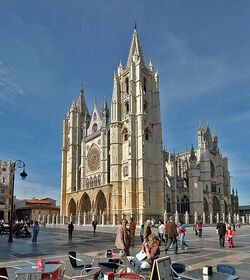Tag: Visual edit |
|||
| Line 153: | Line 153: | ||
|19,976,832 |
|19,976,832 |
||
|283,200 km² |
|283,200 km² |
||
| + | |Françoys-L'Hôpital |
||
| |
| |
||
| ⚫ | |||
| − | | |
||
| ⚫ | |||
| − | <p style="text-align:left;"> |
+ | <p style="text-align:left;">Linusia</p> |
| − | <p style="text-align:left;"> |
+ | <p style="text-align:left;">Bezons</p> |
| style="text-align:left;" |150 |
| style="text-align:left;" |150 |
||
|3.96% |
|3.96% |
||
| Line 167: | Line 167: | ||
|19,929,264 |
|19,929,264 |
||
|339,600 km² |
|339,600 km² |
||
| + | |Trudeau |
||
| − | |[http://classic.particracy.net/viewcity.php?cityid=4097 Dimitri-en-Thallori] |
||
| |
| |
||
| − | <p style="text-align:left;"> |
+ | Dimitri-en-Thallori<p style="text-align:left;">Moisdonne</p> |
| − | <p style="text-align:left;"> |
+ | <p style="text-align:left;">Arloux</p> |
| − | |||
| − | <p style="text-align:left;">[http://classic.particracy.net/viewcity.php?cityid=1053 Arloux]</p> |
||
| style="text-align:left;" |150 |
| style="text-align:left;" |150 |
||
|5.98% |
|5.98% |
||
| Line 182: | Line 180: | ||
|407,400 km² |
|407,400 km² |
||
| |
| |
||
| + | Segre-Sabie |
||
| − | [http://classic.particracy.net/viewcity.php?cityid=1060 Gelle] |
||
| + | |<p style="text-align:left;">Gelle</p> |
||
| − | | |
||
| − | <p style="text-align:left;">[http://classic.particracy.net/viewcity.php?cityid=1059 Segre-Sabie]</p> |
||
| − | <p style="text-align:left;"> |
+ | <p style="text-align:left;">Croix</p> |
| − | <p style="text-align:left;"> |
+ | <p style="text-align:left;">Tenay-les-Cents</p> |
| style="text-align:left;" |150 |
| style="text-align:left;" |150 |
||
|9.37% |
|9.37% |
||
| Line 198: | Line 195: | ||
| |
| |
||
| − | <p style="border:0px;font-weight:normal;margin:0.4em0px0.5em;padding:0px;vertical-align:baseline;color:rgb(58,58,58);font-family:Helvetica,Arial,sans-serif;font-size:12px;font-variant:normal;letter-spacing:normal;line-height:21px;orphans:auto;text-align:right;text-indent:0px;text-transform:none;white-space:normal;widows:auto;word-spacing:0px;-webkit-text-stroke-width:0px;"> |
+ | <p style="border:0px;font-weight:normal;margin:0.4em0px0.5em;padding:0px;vertical-align:baseline;color:rgb(58,58,58);font-family:Helvetica,Arial,sans-serif;font-size:12px;font-variant:normal;letter-spacing:normal;line-height:21px;orphans:auto;text-align:right;text-indent:0px;text-transform:none;white-space:normal;widows:auto;word-spacing:0px;-webkit-text-stroke-width:0px;">Charpentier</p> |
| + | |<p style="text-align:left;">Tiralle</p> |
||
| − | |||
| − | |||
| − | |||
| − | <sup class="reference" id="cite_ref-2">[http://particracy.wikia.com/wiki/Rildanor?oldid=143135#cite_note-2 [3]]</sup> |
||
| − | | |
||
| − | <p style="text-align:left;">[http://classic.particracy.net/viewcity.php?cityid=1052 Labonne]</p> |
||
| − | <p style="text-align:left;"> |
+ | <p style="text-align:left;">Malini</p> |
| − | <p style="text-align:left;"> |
+ | <p style="text-align:left;">Alkenne</p> |
| style="text-align:left;" |150 |
| style="text-align:left;" |150 |
||
|3.91% |
|3.91% |
||
| Line 216: | Line 208: | ||
|19,945,385 |
|19,945,385 |
||
|215,700 km² |
|215,700 km² |
||
| + | |Ville-sur-Cenx |
||
| − | |[http://classic.particracy.net/viewcity.php?cityid=1049 Port Retagne] |
||
| |
| |
||
| − | <p style="text-align:left;"> |
+ | <p style="text-align:left;">Port Retagne</p> |
| − | <p style="text-align:left;"> |
+ | <p style="text-align:left;">Saclay</p> |
| − | <p style="text-align:left;"> |
+ | <p style="text-align:left;">Cenlati</p> |
| style="text-align:left;" |15 |
| style="text-align:left;" |15 |
||
|3.51% |
|3.51% |
||
Revision as of 00:30, 9 July 2020
Motto | |||||||
| Anthem | "La Canrillaise" | ||||||
| Capital (and largest city) |
Arloux | ||||||
| Language | Canrillaise | ||||||
| Religion main |
69% Hosian •65%Aurorian •4% Jacquardism | ||||||
| others | 3% Ahmadi 3% Daenism 2% Agathism 2% Other religion | ||||||
| Ethnic Groups main |
85% Canrillaise | ||||||
| others | 4% Mordusian 3% Indralann 2% Duntrekker 1% Istalian 1% Egelian 1% Majatran 3% Other ethnicity | ||||||
| Demonym | Rildanorien/Rildanorian | ||||||
| Government | Parliamentary Monarchy | ||||||
| Monarch | Jean-Noël IV | ||||||
| President of the Government | André Charpentier (PP) | ||||||
| Legislature | Sénat Royal de Rildanor | ||||||
| Area | 1,679,100 km² | ||||||
| Population | 99,808,503 (4345) | ||||||
| GDP Total: |
671,399,970,708 RCR | ||||||
| per capita | 6 727 RCR | ||||||
| Currency | Rildanorian Crown (RCR) | ||||||
| Time Zone | GMT +6 | ||||||
| summer | GMT +7 | ||||||
| Drives on the | Right | ||||||
| Calling Code | +27 | ||||||
| Internet TLD | .ril | ||||||
| Organizations | Seleyan Union, NSEC, Council of Seleya | ||||||
Rildanor, officially the United Kingdom of Rildanor (Canrillaise: Royaume Uni de Rildanor), is a nation in south-eastern Seleya. It is bordered by Kanjor in the south, Alduria to the west, and Mordusia in the northwest. Rildanor's capital city is Fontaine.
Rildanor is generally perceived to be a developing economy, however, the years under the dictatorship led by Josué Victorieux saw the abandoned of any features of a modern, liberal democracy. Due to this regime, known as État d'Rildanor, only recently Rildanor is recovering many of the economic, social and technological advancements of a developed nation. At present, it operates as a presidentialist republic. In the past, Rildanor was combined with Kanjor and Alduria to form the state of Canrille.
Etymology

Jean de Fleur, an ancient Kanjoran diplomat and historian, was the first to use the word Rildanor.
The name Rildanor most likely comes from the distinct old Canrillaişe dialect words of riche, or rihl, meaning rich or abundant, and nord, or north. The lands of what is now the cantons of Niraldonne and Tiralouse were, and continue to be, very fertile and rich in natural resources such as timber, copper, gold, and silver. The present day name of Rildanor was therefore derived from the old phrase riche (or rihl) du nord, which roughly translates to the wealthy north.
The first use of Rildanor seems to have come from the classical Kanjorien historian Jean de Fleur, who travelled north to the territory of modern-Rildanor in 1620 as part of a diplomatic mission to woo over the local princes. De Fleur saw the thriving communities of the area, particularly the great agricultural output and the seemingly infinite supply of other resources that made the local people rich. On his return to Kanjor two years later, in his initial report de Fleur referred to the land as Rildanor, which impressed the Kanjorien King so much that he quickly encouraged trade with the area and eventual annexation. The name, thereafter, became popularized first outside of Rildanor itself, but was eventually accepted by Rildanorians after the formation of the modern state in 2049.
History
Early History
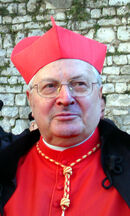
Cardinal Jean Chirac is said to be the father of Rildanorian unification.
Rildanor's pre-state history spans centuries of quarrelling small kingdoms and principalities with no real desire for unified rule. The Kingdom of Tirali, by far the strongest between 1799 and 2008, failed to unite Rildanorians, primarily due to interference from other countries in what is now Mordusia, Alduria, and Kanjor. In 2010, Cardinal Jean Chirac, the first minister to Tirali's King Kamadev, put forth the idea of unification of the Southern Seleyan states under the rule of a common monarch, but negotiations bore little fruit. The power centres of Austrian Mordusia strongly opposed the Tiralian plan, citing little similarities between the scattered peoples of South Seleya.
In 2048, the eastern Aldurian states of Bendiri and Zanyal launched an invasion of the western Duchy of Nirald, supposedly on the basis of historical right that dates back to the 1987 marriage of two aristocratic families that links Nirald with the two invaders. Tirali and the Duchy of Morbanack quickly mobilized their armies in defence of their Niraldanian brothers, quickly repelling Aldurian republican forces in a few months. It soon became apparent, then, that the Rildanorian states had to unite to repel future aggressive action by their neighbours. King Kamadev Jozefus of Tirali convened the fourth and final phase of the unification process and soon united Nirald, Morbanack, and Tirali under the Tiralian monarchy in December 2048. The island Kingdom of Meriath and the Kingdom of Zirdor adamantly refused to join, but would collapse after the bloody War of Rildanor. Kamadev Jozefus of the Leone Family was crowned King of Rildanor in Tirali City, then to be made capital.
Theocratic Monarchy
The birth of Rildanor failed to predict the strong interest of the Theognosian Church in national politics and in the everyday lives of the newly unified Rildanorian people. Christian parties held almost half of the early 36-member Sénat, with its first act of business being the issue concerning prayers in school. Throughout the remainder of the century, the Church would establish strong political and social control over Rildanor in what would be known as the Theocratic Monarchy. This period in the country's history would shape the country's evolution and can also explain the religion's continued existence in modern day Rildanor.
Rildanorian Civil War
The theocratic monarchy, however, soon collapsed amid controversy as both the Church and several aristocrats were engulfed in a scandal regarding the embezzlement of state funds. In 2267, a pro-republican government would unseat Edmund and put in its place the Republic of Rildanor.
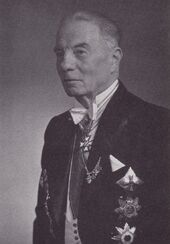
Kamadev Jozefus, the first King of Rildanor.
Many Communist youths were at first ecstatic about the end of the Church and the monarchy, but the republican government failed to address and meet the social issues plaguing Rildanor at the time. A Marxist revolution called MAREM overthrew President Mike Knox in 2270 and declared a Communist Republic shortly after. In 2274, a royalist uprising erupted in Meriath, led by the aging Edmund I and his son Hénri, which soon overran government forces on the island. When news of the revolt reached the mainland, many noblemen and their supporters quickly sailed for Meriath, hoping to rally behind Edmund and restore the monarchy. A planned invasion of Rildanor from Meriath soon took effect and royalist forces focused their attention on the capital Tirali, but the ensuing conflict drew in nearby countries, including Kanjor, Saridan, Aldegar, Kafuristan, Gishoto, Dorvik.
Princesse Arun, Edmund's granddaughter, would be crowned Queen of Rildanor after the Rildanor Peace Treaty was signed in 2285 in the new capital of Labonne, 200 km east of Tirali. The site for the new capital was chosen because of Labonne's defendable location and vast plots of untouched land, in sharp contrast to the more urban and overpopulated scene in Tirali. The Nareath monarchy would go undisturbed until 2401 when a surge in republican support once again overthrew the family.
Union of South Seleya
In the 2450s, Rildanorian politicians introduced the idea of uniting all of southern Seleya under once country, an entity, they say, that makes sense given the near homogeneous Canrillaişe make-up of the region. Negotiations took nearly a decade, but generally well received in both Rildanor and Kanjor, while sparking little interest in Alduria. In May 2461, Rildanor and Kanjor ratified the treaty and officially formed the L'Union de Seleya du Sud (South Seleya). The system retained much of the two countries' systems, with alternating 5-year presidencies and cabinets. South Seleya, however, would eventually dismantle for two reasons; the two countries still largely performed as separate entities, with little being done in the international relations arena. Also, Rildanor had revived strong monarchist sentiments that required a withdrawal from a union with a staunchly republican character, thus ending the union in the 2490s. After 93 years of republican rule, the Nareaths were reinstated to the throne of Rildanor.
The Demitrean dynasty
In the 3350s, the journeyman and warrior Joseph Demitreus led a company of other journeyman warriors and their families, including his brothers Oscar and Louis, and his sisters Caroline and Lucia, to Lourenne. In 3352, after conquering the country, Joseph's band of soldiers proclaimed him Emperor Joseph I of Lourenne. Joseph reigned well until his deposition in a coup in 3364, but his grandson and namesake was restored as Joseph II in the year 3400. After a tumultuous quarter-century, Emperor Marcus I was thrown from power in 3425 and the Demitreus family began their 63-year exile from Lourenne.
During this time, the post of High King of Rildanor became vacant, but the Rildanorian parties desired to retain the monarchy, toying with the idea of an elective monarchy for a while. In the year 3455, Joseph III became Emperor-in-exile of Lourenne, and urged his cousin, Duke Philip of Louives, to put his name forward for the role. This proposal was enthusiastically supported by the Rildanorian parties, and they acclaimed Duke Philip as High King Philippe I of Rildanor, founding a new branch of Demetrei rule.
Geography
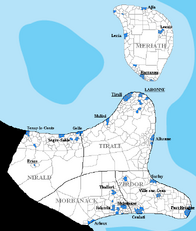
Map of the many districts in Rildanor.
At 1,679,100 km², Rildanor is the world's 7th-largest country, above Saridan and below Deltaria. Rildanor is surrounded by Kanjor in the south, Alduria in the west, and Mordusia in the northwest. It also has maritime borders with Aldegar, Gaduridos, and Indrala.
There are five cantons: Niraldonne , Morbanaque, Tirali, Sirdour, and Meroix. The major lowland regions are Niraldonne and Morbanaque in the west. The Western Plain is essentially a wide river valley through which the Boudigau River flows. This makes the two cantons suitable for agriculture and is the main industry there. The central cantons of Tiralouse and Sirdour have several mountainous and forested areas, but are mainly flat, making it ideal for settlements. The island canton of Meroix is mountainous, though the coastal areas are quite levelled. The central part of the island, however, are known to posses some of the world's largest deposits of various minerals.
Government and Politics
Rildanor's politics has been branded as stable but unpredictable. The unpredictability lies in the several transitions between the monarchy and republic at various stages of the country's history. The stability of the country's politics refers to the normally bloodless and peaceful nature of these political transitions and the fact that few early elections are ever called. See also the Constitution of Rildanor .
Monarchy
The Monarch of Rildanor is the head of state of the United Kingdom of Rildanor, it is a hereditary position to which the current monarch appoints his firstborn as the heir to the crown, the heir will ascend the throne if the previous monarch abdicates or dies. The Monarch in Rildanor is known as King or Queen depending on the gender of the firstborn. The functions of the Monarch is to appoint the President of the Government, he can dissolve the parliament and declare royal prerogative. The current King of the United Kingdom of Rildanor is Jean-Noël IV.
Presidency of the Government
The President of the Government is the head of the government of the United Kingdom of Rildanor. The President of the Government is elected through the Royal Senate and is usually the party leader with the majority in the Senate. The current President of the Government is André Charpentier, who has held the position since April 4769.
Political Parties
- Recently in Rildanor has been re-introduced a multi-party system after the fallen fascist regime.
Sénat Royal de Rildanor
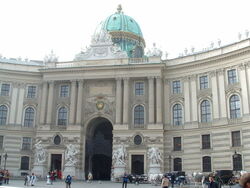
The Parlement Rildanorien in Labonne.
The National Assembly is the nation's current elected legislature. It consists of 750 Senatours Royaux from all five royal provinces. Elections are held every 6 years and registered voters are required to vote.
Executive
Executive authority is exercised by the President of the Government and the Council of Ministers The President of the Government and other cabinet ministers are elected by the Royal Senate. The appointed cabinet heads the Ministères de Rildanor.
There is also a Vice-President of the Government who also holds the position of Minister of Internal Affairs and acts as a temporary head of government in times where the seating President cannot function. For this reason the Vice-President is often asked to succeed to the president's office following the president's sudden death or unexpected resignation, although this is not necessarily constitutionally mandated.
The Vice-President of the Government is often a job that is held simultaneously with the Ministry of Internal Affairs.
The cabinet (Ministères de Rildanor), including the President of the Government and other ministers, collectively make up the government. These ministers are responsible to the Royal Senate and the Monarch.
Military
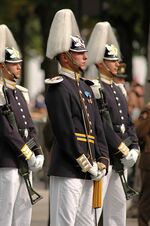
Changing the Guard, at the Château de Fontainebleau-Versailles, Labonne

The Rildanorian Royal Navy conducts naval exercises off the coast of Meriath.
The Army, Navy and Air Force are collectively known as the Rildanorian Armed Forces (Armée Rildanorienne) and officially the Armed Forces of the Crown. The commander-in-chief is the Monarch and they are managed by the Ministry of Defence. The armed forces are controlled by the Defence Council, chaired by the Chief of the Defence Staff.
Rildanor fields one of the most technologically advanced and best trained armed forces in the world. According to various sources, including the Ministry of Defence, Rildanor allocates about 20% of its budget to the military. It is one of the largest spender on military science, engineering and technology.
In 2561, the military had 1.38 million personnel on active duty, along with several hundred thousand each in the Reserves and the National Guard for a total of 2.3 million troops. The Ministry of Defence also employs approximately 700,000 civilians, disregarding contractors. Military service is conscriptory. The rapid deployment of Rildanorian forces is facilitated by the Air Force's large fleet of transportation aircraft and aerial refuelling tankers, the Navy's fleet of eleven active aircraft carriers, and Marine Units at sea in the Navy's oceanic fleets.
The military also includes the Royal Guard battalion, which has two main roles; it serves as the monarch's lifeguards, guarding the royal residences and properties in the country, and is also the main infantry unit responsible for the defence of the capital Labonne. The Royal Guards number at around 25,000 soldiers, including 2,000 men who mainly appear in parades, ceremonies, and other royal functions. The armed forces is in theory under the direct command of the King or Queen of Rildanor. This is rarely the real case, however, as the monarch has a symbolic role rather than a political role.
Foreign Relations
Rildanor is a member of the Accord des Nations Amicales and serves as one of its founding members with veto rights. As a result of this, the country has an influential role in leading dedicated Accord members and Union Canrillaişe parties to war or political pressure. Rildanor also has several fellowship treaties with Indrala, Saridan, Lourenne, and Alduria. The treaties are mainly concerned with the maintenance of peaceful relations and the removal of protective trade policies, including tariffs, discriminatory taxes, subsidies or quotas. The free exchange of cultural and intellectual events/ideas/practises are also main points, which include shared commonalities such as the Canrillaişe character and the long history between the various nations. Rildanor generally approaches its relations with other countries on a cautious, case by case basis, which consequently grants it greater manoeuvrability in the global political arena.
Administrative Divisions
| Name | Status | Population[1] | Area | Capital | Other Cities | Seats | Unemployed |
|---|---|---|---|---|---|---|---|
| Meroix | Royal Province | 19,976,832 | 283,200 km² | Françoys-L'Hôpital |
Saint-Antoine Linusia Bezons |
150 | 3.96% |
| Morbanaque | Royal Province | 19,929,264 | 339,600 km² | Trudeau |
Dimitri-en-Thallori Moisdonne Arloux |
150 | 5.98% |
| Niraldonne | Royal Province | 19,833,817 | 407,400 km² |
Segre-Sabie |
Gelle Croix Tenay-les-Cents |
150 | 9.37% |
| Tiralouse | Royal Province | 19,933,080 | 433,200 km² |
Charpentier |
Tiralle Malini Alkenne |
150 | 3.91% |
| Sirdour | Royal Province | 19,945,385 | 215,700 km² | Ville-sur-Cenx |
Port Retagne Saclay Cenlati |
15 | 3.51% |
| Total[7] | 99,618,378 | 1,679,100 km² | 750 | 5.35% | |||
- ↑ 4771 estimates. Last census was held in 4771.
Demographics
Rildanor's population has surpassed 100,114,433 in 2575 and the country proudly has the largest Canrillaişe population anywhere on Terra. In 3210, the government conducted a study to determine demographics of the country. The results are published in the Recensement national - Rildanor Census, 3210 bill.
Ethnicity

Cathedrals are a common sight in many major Rildanorian cities, such as the Cathédrale Notre-Dame de Arloux in Arloux, Morbanack.
Approximately 89% of all Rildanorian residents identify themselves as Canrillaişe-Rildanorienne (mixed with minority Canrillaişe speakers whose ethncity comes from Alduria, Kanjor, and Lourenne, Rildanor's immediate neighbours and historic partners). With over 99 million Rildanorians, a vast array of cultural traditions have thus been handed down for centuries and continues to be practised and honoured today. About 4% of the population come from Mordusia, 3% from Saridan, and 1% from Indrala. Although most of them are technically Canrillaişe, they continue and prefer to be identified by their country of origin. The remaining 1% are foreign diplomats/businessmen, illegal aliens and people of mixed descent.
In 3210, the government attempted to limit the non-Rildanorian, and specifically the non-Canrillaişe, population by removing ethnic minorities and immigrants in the Deportation of Migrants and Minorities Act. However, when Philippe I was elected High King, he instructed the Parliament to open Rildanor for immigration subjected to quotas for skilled and learned applicants and workers with the condition of mandatory learning of Canrillaişe language and culture, thus getting international solidarity and favor. This act of Rildanor of opening gates to the world becomes popular not only for foreigners but also for nationals because of tremendous high impact to the economy and high standard of living due to tourism and more direct foreign investments (however managed by the King's national company or controlled by Parliament).
Religion
- The largest religious group in Rildanor is Theognosianism, comprising of more than 70% of the country's population. While a growing number of Rildanorians do not actively practice the national faith, most still continue to identify with the Church for historical and cultural reasons. Patriarchal believers registered close to 2% while Queranzariah (Muslim) members numbered around 1%. At 26%, atheists (or those who do not adhere to any religion) have grown throughout the country and is a reflection of Rildanor's changing attitudes toward organized religions.
Language
Rildanor's official language is Canrillaişe and was formally recognized as such in the Official Canrillaişe Act, 2368. The bill is a further recognition of the country's true Canrillaişe identity and its dominance among the world Canrillaişe population although since Rildanor's popular breakaway from the unpopular and selfish Empire de la Canrille.
Canrillaişe is today mandatory in schools, workplaces and government, and programs are funded by the Rildanor Government to promote it outside of the country, particularly in South Seleya where there are countries with sizable Canrillaişe populations. Other languages, however, are still widely tolerated and protected under law (Rildanor has ratified the Protection of Minority Languages Treaty and also declared Luthori as official language).
Economy
| Economy of Rildanor | |
|---|---|
| National economic indicators | |
| Unemployment | 5.3% |
| GDP growth | 4.9% |
| CPI inflation | 3.0% |
| National debt | none |
| Poverty | 6.3% |
Rildanor is one of the Seleya's wealthiest nations, with a high per-capita income and robust annual growth rates, fuelled by abundant natural resources, a well-developed infrastructure, and high productivity. As of September 3522, Rildanor is the 4th largest in terms of GDP, 7th largest in investments, 7th largest in consumption, 16th largest in taxes, and 16th largest in government spending. Different governments of Rildanor has experimenting different schemes on budget and tax proposals so that there will be an increase in investments. Currently, it has no tax imposed on corporations for them to generate high income and high employment rate.

The automobile industry is especially profitable in both domestic and international markets.
The private sector constitutes the bulk of the economy, with government activity accounting for 12.4% of GDP. The economy is postindustrial, with the service sector contributing 67.8% of GDP. The leading business field by gross business receipts is wholesale and retail trade; by net income it is finance and insurance. Rildanor remains an industrial power, with chemical products the leading manufacturing field. It is one of the largest producers of oil in the world, and also one of its largest consumers.
Rildanor is one of the world's most important suppliers of agricultural products, with Morbanack and Nirald being one of the most important suppliers of wheat, canola and other grains. Rildanor is the world's largest producer of zinc and uranium and a world leader in many other natural resources such as gold, nickel, aluminum, and lead; many, if not most, towns in the canton of Meriath, where agriculture is difficult, exist because of a nearby mine or source of timber. Rildanor also has a sizable manufacturing sector centred in Tirali and Zirdor, with automobiles and aeronautics representing particularly important industries.
The service sector of Rildanor is dominated by financial services, especially in banking and insurance. The Rildanorian manufacturing sector, however, has greatly diminished, relative to the economy as a whole, since the 24th century. It is still a significant part of the economy, but only accounted for one-sixth of national output in recent years.
Culture
The culture of Rildanor and of the Rildanorian people has been shaped by its geography, by profound historical events, and by foreign and internal forces and groups. Rildanor, and in particular Labonne and Tirali, has played an important role as a centre of high culture and of decorative arts since the twenty-first century, first in Seleya, and from the twenty-second century on, world wide. The importance of Rildanorian Canrillaişe culture has waned and waxed over the centuries, depending on its economic, political and military importance. Today it is marked both by great regional and socioeconomic differences and by strong unifying tendencies.
Cuisine

Rildanorian cuisine is as much about presentation as it is about taste.
Traditional Rildanorian culture places a high priority on the enjoyment of food. Cuisine was codified in the 23rd century by Antoinne Auguste, effectively placing greater importance on a more unified cuisine that overshadowed regional varieties. Rildanorians typically eat only a simple breakfast ("petit déjeuner") (of, say, coffee or tea, served traditionally in a large handleless "bol" and bread, breakfast pastries (croissants), or yogurt. Lunch ("déjeuner") and dinner ("dîner") are the main meals of the day. Formal four course meals consist of a starter course ("entrée"), a main course ("plat principal") followed by a salad course, and finally a cheese and/or a desert course. While Rildanorian cuisine is often associated with rich deserts, in most homes desert consists of only a fruit or yogurt.
In Rildanor, cutlery is used in the continental manner (with the fork in the left hand, prongs facing down and the knife in the right hand). The legal drinking age is officially 18 for strong liquors (21% vol. alcohol), and 16 for most alcohol drinks (beer, wine, etc.). Wine, in particular, usually accompanies both lunch and dinner meals, while other liqueurs are occasionally enjoyed.
Sports

The Vendée Globe is a round-the-world single-handed yacht race, sailed non-stop and without assistance.
The Rildanorian national sport is football (soccer), colloquially called 'le foot'. The most-watched sports in the country are football, rugby, basketball, cycling, sailing and tennis. Rildanor is notable for holding a series of national and international football championships, as well as the annual cycling race Tour de Rildanor. Meroix Canton also came second in the first and only (so far) Terran Supercup of Regions Sports are encouraged in school, and local sports clubs receive financial support from private companies, if not from local governments and community groups. Professional sailing is also popular and is centred on singlehanded/shorthanded ocean racing, with the pinnacle of this branch of the sport being the Vendée Globe single-handed competition, which is a race around the world that takes place every 4 years off the coast of Meriath.
Media
Rildanorians are among the greatest consumers of newspapers in the world, and nearly every town is served by a local paper. The country's main quality morning papers are The Rildanor Daily, focused mainly on domestic events, and The Rildanor Journal, an international paper that is the main news source for foreign governments and Rildanorian nationals living abroad. However, there is a state media channel strictly regulated by the government.
Gallery
| Rildanor articles | ||
| History | Union Canrillaişe | |
| Geography | Cities | |
| Politics | Political parties - Supreme Court - Elections - Viceroy - Prime Minister - Ministers - National Asssembly - Opposition | |
| Demographics | Ethnic groups: Canrillaise Religion: Aurorian Patriarchal Church | |
| Culture | Sport - Monarchy - Armed Forces - National anthem - Nobility | |
| Economy | Banking | |
| Nations of Seleya | ||
| Sovereign states | Aldegar - Alduria - Baltusia - Gaduridos - Indrala - Kalistan - Kanjor - Likatonia - Lodamun - Mordusia - Rildanor - Saridan - Tukarali - Valruzia | |




